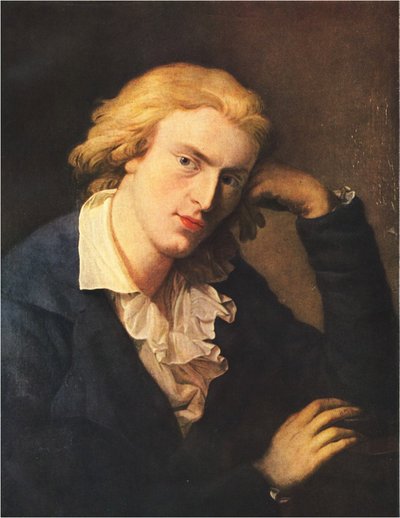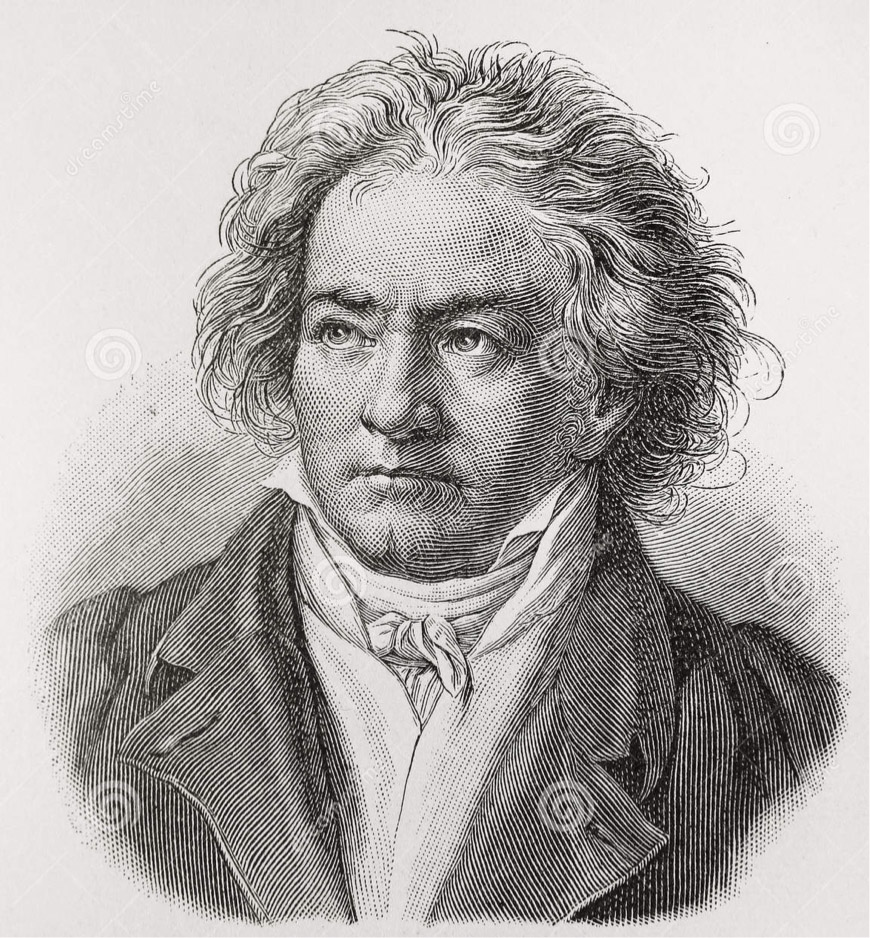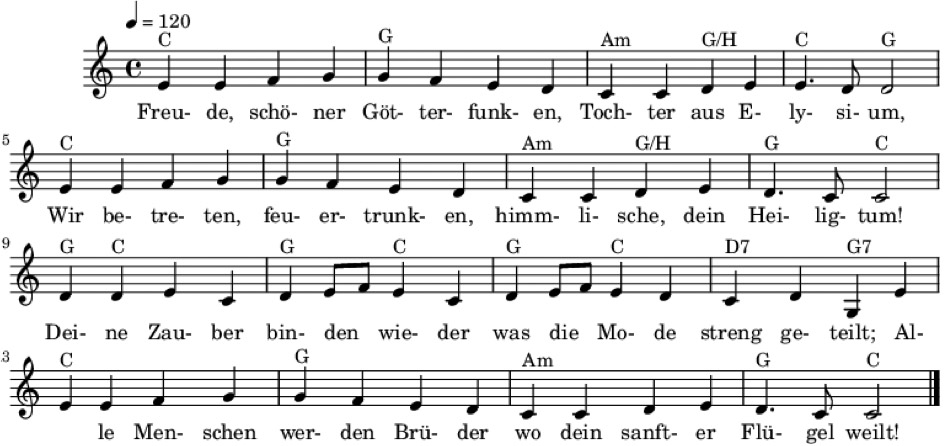«Every man becomes a brother» – an ideal of humanity even 250 years after Beethoven's birth
Who can’t recite the first lines by heart or at least sing the world-famous melody to himself: We are referring to Friedrich Schiller's ode "An die Freude" ("To Joy") (1785) for which Ludwig van Beethoven, whose 250th birthday we are celebrating this year, presented an extraordinary musical monument in his Ninth Symphony (1824) some forty years after its composition. All over the world "the Ninth" has a reputation. It is repeatedly performed everywhere. Why does this music speak to the hearts of so many people in such a way that their faces light up instantly when they hear or sing it? How did it come about that the two congenial spirits, Schiller and Beethoven found each other and created a summit of Western cultural history?
Friedrich Schiller's poem "To Joy" - ode or drinking-song?
Friedrich Schiller (1759-1805) never called his work an ode. He did not consider it one of his strongest poems. Strictly speaking, it is not an ode at all but a drinking song, a less sublime genre of lyric poetry. Ode (Greek) originally refers to a text that is sung to music, i.e. a song. In ancient Greece, the prize songs of the poet Pindar (5th century BC) were called odes in honour of the winners of sporting competitions. From this basic form, hymnal odes in the sense of prize songs with religious content developed.
Drinking songs have been known since Roman antiquity. They were sung at social gatherings where alcoholic beverages were consumed. Some passages in Schiller's poem have this character.1 For example, in the sixth verse of the chorus
Joy doth bubble from this rummer,
From the golden blood of grape
Cannibals imbibe good temper,
Weak of heart their courage take —
Brothers, fly up from thy places,
When the brimming cup doth pass,
Let the foam shoot up in spaces:
To the goodly Soul this glass! 2
Schiller's poem "An die Freude" probably received the name "Ode" from a publication entitled "Fourteen Compositions to Schiller's Ode to Joy".3 Be that as it may, both names fit. Praise is given to the exuberant joy that spreads when people fraternise and - according to their destiny - live together in harmony all over the world in the spirit of their Creator.
Schiller wrote the verses at the age of 25. In Mannheim, to where he fled from Stuttgart, Schiller experienced the premiere of the "Räuber", his first brilliant theatre success which made him famous far and wide. Later due to conflict with the artistic director and the ensemble he travelled to Leipzig, where a kind of fan club had been formed around Christian Gottfried Körner, an enthusiast of Schiller’s plays. The poet of Sturm und Drang was received with great joy, offered accommodation and a livelihood. Friendship was cultivated with him in all kinds of meetings and activities. Alliances of friendship were a phenomenon of the times: people swore to each other, eternal loyalty and succumbed to feelings of happiness.
In the mood of this time, to which wine also contributed to its bliss, Schiller completed his poem "To Joy", in which he not only sketched out the vision of worldwide friendship amongst all people, but also made them swear the following:
Courage firm in grievous trial,
Help, where innocence doth scream,
Oaths which sworn to are eternal,
Truth to friend and foe the same,
Manly pride ’fore kingly power —
Brothers, cost it life and blood, —
Honor to whom merits honor,
Ruin to the lying brood! 4
With this poem, Schiller creates a vision in which the values and goals of enlightenment - such as reason, justice, equality, freedom, tolerance and interpersonal bonds and compassion - are realised. A few years later, with the storming of the Bastille (14 July 1789), the French Revolution set out to achieve these goals. Schiller and Goethe, however, firmly opposed the Jacobin excesses of violence that led to the reign of terror of 1793/94. It was clear to them that the goal of a just and humane social order could not be achieved by force, but through enlightenment - education and training of the individual - as their works of the Weimar Classicism emphatically show.
Ludwig van Beethoven's Music for the stage
Ludwig van Beethoven (1770-1827), "Schiller reader, Goethe devotee and Kant admirer"5 , explicitly joined this philosophical-literary movement with some of his compositions. These works were about the role of man in the course of history, about the striving for the realisation of ideas and values. In the ballet "The Creatures of Prometheus" (1801) by the choreographer Salvatore Vigano, to which Beethoven wrote the music, the hero is not the rebellious titan, but "an enlightened philosopher and teacher who brings reason and knowledge to the uneducated and ignorant 'creatures'".6 He also wrote the music for Goethe's tragedy "Egmont" (1809). It is about the Dutch CountEgmont, who joins the resistance of the Dutch against Spanish rule in the 16th century and who is captured and sentenced to death. Finally, in his only opera, "Fidelio" (1805), the Spanish nobleman Florestan, who was fond of the ideals of Enlightenment, was freed from imprisonment with the self-sacrificing help of his wife, whereupon the prison gates opened for all prisoners.
Beethoven's symphonies also deal with questions of human existence, conveying ideas, values and visions.7 This is done purely instrumentally, especially in the Third (1805) and Fifth (1808) Symphonies and in the Ninth Symphony (1824) with choir and vocal soloists intoning parts of Schiller's poem. The Third Symphony is entitled "Eroica", which already makes it clear that Beethoven is addressing the questions of heroism. Originally, he had dedicated it to Napoleon, but withdrew the dedication "Intitula Bonaparte" because the latter crowned himself with the imperial crown on 2 December 1804 in Notre-Dame de Paris. The Fifth Symphony with its rhythmic opening motif (known as "Ta, ta, ta, taaa!") is no less well known than the Ninth; indeed, it is probably one of the most popular pieces of classical music ever. Whether or not it is a "symphony of fate" - the controversial name, according to his secretary, is supposed to come from Beethoven. In any case, the composer brings to this work "a previously unknown tragic dimension".8 "Just as the audience was gripped by Schiller's Die Räuber in 1787, they were now shocked by Beethoven's Fifth Symphony.9 The Third Symphony and the Fifth Symphony are significant in music history as milestones of symphonic music, but also as works of art in their own right, and represent a kind of bridge to the Ninth Symphony.
"The Ninth" - the most important symphony of all time
This is what the Greek-Russian conductor Teodor Currentzis (* 1972) said in theTV documentary "Beethoven's Ninth Symphony for the World "10, which is worth watching. Impressively, the film shows that this work won over the entire world. It is sung and played around the globe by young and old. People of all cultures and skin colours are inspired by it. From the very first note, no one can escape the dynamics and rhythm of this music. It immediately becomes clear: here, Beethoven created something that was never heard before, something monumental. The dimensions alone leave a lasting impression: the first three movements are as long as an entire symphony, the fourth, with solo, quartet and choral singing, has the stature of a cantata.
Power and determination mark the electrifying opening and the entire course of the first movement ("Allegro ma non troppo"), the second ("Molto vivace") has a forward, rhythmic character, while the third ("Adagio molto e cantabile") is filled with lyrical calm. At the beginning of the fourth movement, massive dissonances are heard, followed by a series of repetitions of all the motives of the first three movements, before the "Freudenthema", still purely instrumental is already intoned. The dissonances known from the beginning of the movement interrupt the rest of the movement, whereupon a baritone raises his voice with the words: "O friends, not these notes, rather let us tune in more pleasantly and with more joy!" A vocal quartet (soprano, alto, tenor, bass), first followed and then accompanied by a choir, sings the first verse and the chorus of Schiller's poem until the finish which leads into a "Presto", Maestoso" and "Prestissimo".
Beethoven did not include the entire text in his setting, but the first verse could not be omitted: The joy - spark of the gods - comes from Elysium, the island of the blessed. The ode "to joy" gives us humans a glimpse of what it is like when we all enter the Shrine of Joy and experience what it means to live in complete harmony and to share a world in which all that divides us is removed:
Thy enchantments bind together,
What did custom stern divide,
Every man becomes a brother,
Where your gentle wing dwells. 11
At the end of the song, Beethoven combines two verses of the chorus into one:
Be embrac’d, ye millions yonder!
Take this kiss throughout the world!
Brothers—o’er the stars unfurl’d
Must reside a loving Father. 12
Fall before him, all ye millions?
Know’st thou the Creator, world?
Seek above the stars unfurl’d,
Yonder dwells He in the heavens. 13
The symphony ends with the certainty that all people may know themselves in the hand of a benevolent creator, who offers the guarantee that all people will one day be united in peace. Who can stand aside when this dream of mankind is celebrated with choir and orchestra?
Abuse and Use of the "Ninth"
Like all great works of art - be it literature, music or the visual arts - that address political issues or create a utopia, Beethoven's Ninth was and is used and abused. A few examples may illustrate this.14
In the 19th century, during the revolution of 1848, the democratic movement rejoiced in the support of Schiller and Beethoven. When Richard Wagner rehearsed the symphony in Dresden during the barricade fights, Mikhail Bakunin was among the listeners.15 In 1918, after the First World War, the labour movement took advantage of the work for the peace movement: On New Year's Eve 1918, when not only the end of the war but also the end of the monarchy was celebrated, the tradition of performing the Ninth at the turn of the year began, which continues in various places to this day.
The National Socialists were quite different, of course, who pretended to take up the fraternisation of people, but in all seriousness bent it into a "legitimisation to subjugate and interrogate other countries and peoples".16 However, according to Hanns Eisler, composer and companion of Bertolt Brecht, whose works he set to music, the text would then have read quite differently: "All men become brothers, except all peoples whose land we want to annex, with the exception of Jews, Negroes and many others".17
In 1972, the Ninth became the instrumental version of the Council of Europe's anthem, before being declared the anthem of the European Community (now the European Union). Finally, for the German reunification in December 1989, Leonard Bernstein conducted the work in Berlin's Schauspielhaus am Gendarmenmarkt, which was performed by musicians from East Berlin, Dresden, Leningrad, New York and Paris. He took the liberty of replacing the "joy" of Schiller's original text with "freedom", an idea of a certain persuasive power.
Can art or music change the world? Truly a great question and always a subject of lively debate. In terms of music history, the impact of Beethoven's ninth symphony took on extraordinary dimensions: No composer after him could avoid "The Ninth", it had set completely new standards which are still effective today.18 In the meantime it even reached the charts: Accompanied by an orchestral arrangement by the Argentinean Waldo de los Rios, the Spanish singer Miguel Rios sang his "Song of Joy", which became a world hit in the 1970s.19 When popular texts and melodies are spread around the globe via contemporary arrangements, they can connect to the longings of millions of people around the world, awaken hopes and encourage them to stand up for something good. Schiller and Beethoven's masterpiece, which as a milestone of European poetry and music continues to exert a lasting influence to this day, is probably best revealed to the unbiased listener if he or she succeeds in hearing it "as a utopia, as an individual's yearning wish and as an appeal to humanity".20 This is what everyone who listens to it in the Beethoven Year should wish for. •
1cf. Voss, Egon. "«Von der Oper zur Sinfonie, von der Sinfonie zur Kantata. Wie Berg und Beethoven die Formen sprengten» (From opera to symphony, from symphony to cantata. How Berg and Beethoven broke forms), in: Stiftung LUCERNE FESTIVAL (ed.), Symphony Concert 10, August 28, 2019, Berlin Philharmonic, Rundfunkchor Berlin, Kirill Petrenko, Soloists, Concert Program, Stans 2019, p.17ff., Feature by Tobias Barth, Lorenz Hofmann: Ode to Joy, How a Drinking Song Became the European Anthem. Deutschlandfunk (DLF), https://www.deutschlandfunkkultur.de/ode-an-die-freude-wie-ein-trinklied-zur-europahymne-wurde.976.de.html?dram:article_id=448810
2 https://archive.schillerinstitute.com/transl/schiller_poem/ode_to_joy.pdf
3 LUCERNE FESTIVAL Foundation (ed.), Symphony Concert 10, 28 August 2019, op. cit., p. 17
4 https://archive.schillerinstitute.com/transl/schiller_poem/ode_to_joy.pdf
5 Hinrichsen, Hans-Joachim (text); Ruckstuhl, Christoph (pictures). "Beethoven – unser Zeitgenosse?” (Beethoven - our contemporary?) in: Neue Zürcher Zeitung of 21 March 2020, p. 45
6 Lockwood, Lewis. Beethoven: Seine Musik. Sein Leben (Beethoven: His music. His Life), Kassel 2012 (2nd ed.), p. 117
7 Cf. Geck, Martin. Ludwig van Beethoven, Reinbek 2014, p. 155ff.
8 Lockwood, Lewis, op. cit., p. 171
9 ibid.
10 Berger, Christian; Kleber, Chatharina; Roddewig, Martin; Wischman, Claus; Director: Berger Christian. ZDF Documentary 2020 "Beethovens Neunte – Symphonie für die Welt” (Beethoven's Ninth - Symphony for the World)
11 https://archive.schillerinstitute.com/transl/schiller_poem/ode_to_joy.pdf
12 https://archive.schillerinstitute.com/transl/schiller_poem/ode_to_joy.pdf
13 https://archive.schillerinstitute.com/transl/schiller_poem/ode_to_joy.pdf
14 Stähr, Susanne. "Das missbrauchte Kunstwerk, Wie Sozialisten und Nationalisten Beethovens Neunte für sich vereinnahmten” (The Abused Work of Art, How Socialists and Nationalists appropriated Beethoven's Ninth for themselves), in: LUCERNE FESTIVAL Foundation (ed.), Symphony Concerto 10, op. cit., pp. 21-23
15 cf. Stähr, Wolfgang. "Der Freude schöner Götterfunken hat gezündet” (The joy of beautiful sparks from the gods has ignited), in: Neue Zürcher Zeitung, 21 March 2020, p. 52
16 Stähr, Susanne, op. cit. p. 22
17 Stähr, Wolfgang, op. cit.
18 Cooper, Barry (ed.). The Beethoven Compendium, His Life - His Music, Munich 1972, p. 366f.
19 See Wikipedia on the keyword "Ode to Joy”: https://en.wikipedia.org/wiki/Ode_to_Joy
20 Dobretsberger, Barbara. "Ludwig van Beethoven, Symphony No. 9", in: Booklet to the CD: Tonhalle Orchester Zürich, David Zinman, Conductor, Ludwig van Beethoven, Symphony No. 9, Arte Nova Classics 1999, p. 3


